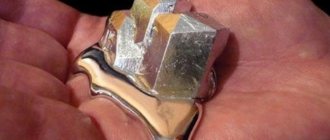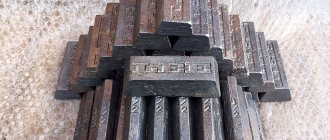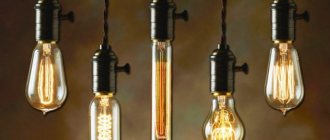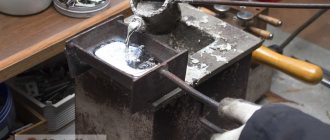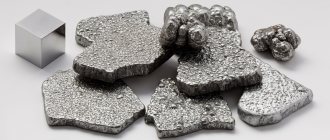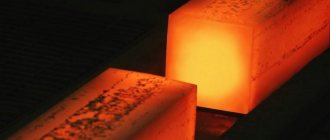Lead occupies number 82 in D.I. Mendeleev’s periodic table. It is a silvery, malleable metal that has a silvery tint. Many people who held this material in their hands noted its high specific gravity. Lead has a low melting point and is therefore easy to process.
Melting lead in production
Lead Characteristics
Our planet contains 0.0016% of lead from the total mass of the earth's crust. Although this figure is small, however, when compared with other chemical elements - bismuth, gold, mercury, lead is in a much higher position.
The predominant source of raw materials is sulfide polymetallic ores . Metal has the following qualities:
- softness;
- low melting point;
- You can process this metal yourself.
This material is characterized by a dirty grayish tint . In the cut area, the metal has a bluish tint, which gradually becomes dull. This is due to the oxidation process, which occurs due to the influence of oxygen. An oxide layer is formed on the cut.
To understand what products lead is suitable for, you need to understand its technical characteristics:
- Cubic crystal lattice.
- The heat of fusion is 327 degrees Celsius.
- Hardness - from 3.2 to 8 HB according to Brinell.
- Elongation - up to 70%.
- Compression limit - up to 50 MPa.
- Tensile strength - up to 13 MPa.
- Voltage resistance - 0.22 Ohm.
- Density - 11.34 g/cm³.
It lends itself well to various types of processing even without heating.
If we talk about the inert properties of the metal, then we can highlight its high resistance to corrosion. This is due to the presence of an oxide film. Withstands prolonged exposure to sulfuric, phosphoric, and acetic acid.
Historical information
The chemical element has been known to people since ancient times. One of the first methods of metal extraction mastered by man was the smelting of lead. The first archaeological finds confirming this were lead beads found from the times of Çatalhöyük (modern Turkey). The items date back to 6400 BC.
The oldest lead figurine of a girl in long clothes was excavated in Egypt. It dates back to the time of the first dynasty of the pharaohs (3000 BC).
Lead pipes made up the ancient Roman water supply system. In the Ancient Roman Empire, up to 80 thousand tons of this metal were smelted annually. In Rus', since ancient times, lead has been used as roofing for cathedrals and churches.
Since time immemorial, the low melting point of lead has made it possible to obtain the metal and manufacture products of any shape from it.
Note! Over the course of 20 years, the Industrial Revolution since 1840 has raised the volume of annual lead smelting in the world from 100 to 250 thousand tons per year.
Getting Lead
The main source of lead is sulfide polymetallic ores, the mineral galena PbS. At the first stage, the ore is enriched. The resulting concentrate is subjected to oxidative roasting:
2PbS + 3O2 = 2PbO + 2SO2↑.
During firing, fluxes (CaCO3, Fe2O3, SiO2) are added. They form a liquid phase that cements the mixture. The resulting agglomerate contains 35–45% Pb. Next, the lead (II) and copper oxide contained in the agglomerate are reduced with coke:
PbO + C = Pb + CO↑ and PbO + CO = Pb + CO2↑.
Rough lead is obtained by reacting the original sulfide ore with oxygen (autogenous method). The process takes place in two stages:
2PbS + 3O2 = 2PbO + 2SO2↑,
PbS + 2PbO = 3Pb + SO2↑.
For subsequent purification of crude lead from impurities of Cu, Sb, Sn, Al, Bi, Au, and Ag, it is purified by the pyrometallurgical method or electrolysis.
Countries are the largest producers of lead (including secondary lead) in 2004 (according to ILZSG), in thousand tons:
| EU | 2038 |
| USA | 1498 |
| China | 1256 |
| Korea | 219 |
Being in nature
Soldering aluminum
Plumbum is usually not found in its pure form. It is found in more than 100 different minerals in the form of intermetallic agglomerates. Lead is present in uranium and thorium veins. Large accumulations of lead-zinc ores have been discovered and are being developed in Transbaikalia and the Primorsky region. Lead is mined in various deposits in the Urals and Norilsk.
The largest deposit with a high content of lead is located in the uranium ores of the Kohistan Ladakh arc (northern Pakistan).
Fossil lead
Melting point of lead
The temperature at which lead begins to boil is 1751 degrees.
This metal begins to melt at a temperature of 327.46 degrees Celsius . Its casting qualities are fully preserved within the range from four hundred to four hundred and fifty degrees.
And the oxide film, which protects the material from corrosion, begins to melt only at a temperature of 850 degrees Celsius, which makes it difficult to weld this type of metal with others. In addition, the volatility level of lead increases significantly at a temperature of 700 degrees.
The material is perfectly processed even when chilled. You can make a thin layer of foil from it. If this metal is subjected to a pressure of 2 tons per square centimeter, then it takes on the appearance of a monolith.
Wire is made from it by pressing in a die. The low degree of tensile strength does not allow the use of ordinary drawing for this purpose.
Physical properties
Lead has a rather low thermal conductivity, it is 35.1 W/(m K) at a temperature of 0 °C.
The metal is soft, can be cut with a knife, and is easily scratched with a fingernail. On the surface it is usually covered with a more or less thick film of oxides; when cut, a shiny surface is revealed, which fades over time in air. Melting point - 600.61 K (327.46 °C), boils at 2022 K (1749 °C). Belongs to the group of heavy metals; its density is 11.3415 g/cm3 (at +20 °C). As temperature increases, lead density decreases: Change in lead density depending on temperature
| Temperature, °C | Density, g/cm3 |
| 327,6 | 10,686 |
| 450 | 10,536 |
| 650 | 10,302 |
| 850 | 10,078 |
Tensile strength - 12-13 MPa (MN/m2).
At a temperature of 7.26 K it becomes a superconductor.
Preparing to smelt lead
To start preparing to melt lead, you need to find a container. It would be great if the handle of the vessel was made of some heat-resistant material. For this purpose, you can use an old coffee pot or kettle.
The material can also be melted in an outdated container made of cast iron, using a deep and long spoon for pouring .
If there is no suitable container nearby, then you can use an ordinary tin can. However, here you should use pliers , which will be used to remove the hot pan from the flame and pour the material into the mold.
Do not forget that you need to be extremely careful while working. To simplify the procedure, you can make a small groove . In this case, the red-hot metal will pour out in a thin stream clearly into the required place.
The material, cleared of impurities, can be crushed so that it melts as quickly as possible. The container must be securely placed over the burner and heated properly . This must be done in order to rid the surface of excess impurities and moisture.
Methods for getting rid of oxide
When exposed to air, lead products become covered with an oxide film. This is the result of the ionic interaction of oxygen and lead atoms. The oxide becomes not only protection against an aggressive environment, but also a barrier to electric current.
Important! Mechanical cleaning will not bring the desired result. The film will recover quite quickly. Sunflower oil, graphite grease or varnish can help get rid of oxides.
At home, the product is placed in a vessel with sunflower oil for about five minutes. After which it is removed from the vessel and allowed to dry.
In industrial conditions, graphite lubricant is used. The lead surface treated with the product retains its shiny appearance for a long time.
Lead smelting procedure
There is no need to try to melt all the prepared lead at once, because only the very bottom layer will interact with the hot surface of the container.
First melt two or three pieces to form a puddle, then gradually add new material . This will give you the opportunity to make your work area more voluminous.
After melting, a layer of debris, impurities and slag must be removed . Pouring must be done into a heated mold. Lead is also characterized by rapid solidification. The material quickly loses its fluidity, becomes thicker, and therefore cannot completely fill the mold.
Application areas of lead alloys
Lead is actively used for a chemically produced current source. About ¾ of the total mass of metal produced is used to create lead-acid batteries. Despite competition from alkaline energy sources, lead produces higher voltage electricity. The element is used for windings of superconducting transformer systems. The component was one of the first substances noticed with superconducting properties. Lead alloy (babbitt) has found application in the creation of bearings due to its anti-friction properties. Lead is widely used to create electrical safety systems due to the ability to create low-melting compounds with other metals (cadmium or tin).
Lead is actively used in human life support. The use of plumbum in industry makes it possible to produce the following products and substances:
- plates for car batteries;
- cast fonts used in printing houses for printing text information;
- shells for protecting power cable and wire products;
- various alloys and soldering compounds;
- bearing connections;
- sinkers for fishing;
- coloring mixtures (dyes);
- shot and bullets for hunting rifles;
- a variety of protective equipment against the harmful effects of radioactive radiation.
More recently, this popular metal was even used as a fuel additive to increase octane and search for hydrogen sulfide (H2S), but this method was gradually abandoned due to the toxicity of lead.
Since plumbum is a toxic chemical, when working in deposits of various ores, using this metal and compounds with it in production and during its smelting, poisoning of the body is possible. If you experience any discomfort when working with it, it is recommended to immediately seek help from a doctor.
Household lead poisoning is also possible, for example, when consuming products that have been stored for a long time in dishes or packaging materials that contain this substance.
The low melting temperature of lead, its viscosity and pliability, as well as a number of other quantitative and qualitative properties of this metal make it truly invaluable in human life.
Tin-lead solders
The industry supplies the solder product to the market - tin-lead solders:
- cast pigs;
- wire;
- foil tape;
- solder tubes with flux;
- powder or paste.
Alloys containing 90% tin and 10% lead are used for soldering products, which are then electroplated with gold or silver. The melting point of pure tin is 2310 C. Therefore, the solder will melt when heated to 2200 C.
Tin-lead POS with a predominance of tin in its composition (61%) has a lower melting point - 191%. POS 61 is used to cover contact groups in various devices; it is also used to process thin wire for windings of electric motor armatures and transformer coils.
Taking into account the temperature at which tin melts, the % lead content in the alloy is regulated. This achieves a comfortable temperature regime, at which the tin-lead solder quickly turns into a liquid state.
POS 30 melts at 256 degrees. The compounds are less durable than products with a higher tin content.
10 percent solder is far from the temperature threshold at which tin melts. Therefore, POS 10 is used as a durable material for tinning large metal surfaces.
Preparing the melt and pouring lead
In industrial conditions, the melt is prepared in special crucibles, which are placed in electric furnaces (equipment equipped with electronic measuring equipment that maintains the desired melting mode).
In radio engineering production, special heating baths are used to prepare solder for printed circuit boards of radio circuits.
In workshops and at home, solder is melted with a soldering iron tip. To prepare a large volume of molten metal, it is placed in a copper vessel on an electric stove. The alloy in the form of scrap is loaded into the melting bath gradually, as the next layer of metal melts.
Lead fishing varnishes
Avid fishermen at home cast fishing sinkers and spoons by pouring molten tin into clay molds. The spoons are then coated with waterproof varnishes.
Fishing varnish is used to protect against the appearance of oxides on various figurines and other products.
You can coat the lead figurine with metal varnish. In a store that sells products for fishermen, you can often find a special “fishing” varnish designed specifically for such purposes. There are a variety of colors available, but if you want to maintain a metallic sheen, clear is best for you. The industry also produces fluorescent “fishing” varnishes.
Do-it-yourself lead smelting
Lead, which has a low melting point, makes it possible to use it for self-casting of various figures and crafts, jewelry, sinkers for fishing, and bullets for hunting.
It is important to adhere to generally accepted safety rules when melting metallic substances and to be very careful when doing so. Melting of pure lead or alloys based on it must be carried out according to the following set of instructions and recommendations:
- The room in which the metal will be melted must be well ventilated. This process can also be carried out outdoors;
- A hand burner can act as a heat source, and any vessel made of a more heat-resistant and durable metal material will be suitable as a melting container;
- The process of melting plumbum is simple - after placing the material in the vessel, it is necessary to turn on the heat source at the maximum possible power and concentrate the heat flow directly on the lead substance. The transfer of a large amount of material into a liquid state does not occur immediately, but after a certain amount of time;
- After completing the procedure for melting the lead alloy, you must turn off the burner. The material can be immediately poured into casting molds, which must be prepared in advance;
- The container with the resulting liquid can only be handled with special heat-resistant gloves. At the same time, it must be carefully twisted in a circle to prevent the formation of air bubbles;
- Pouring liquid lead into a casting mold should be done at arm's length to prevent burning of exposed areas of the body by hot fumes from the metal;
- After filling the molding container, it must be left to cool to an acceptable safe temperature;
- If a spill occurs when pouring raw materials into molds, it can be easily removed by mechanical action with a screwdriver or chisel after hardening. These pieces can then be used for subsequent melting;
- It is worth considering that the metal mixes well with other metals. Accordingly, taking into account the parameters of these additional components, you can independently produce various alloys, bringing the melting temperature to the required value. For example, by adding a certain amount of tin and a little rosin to the molten plumbum, you can get good homemade solder for soldering non-ferrous metals with good electrical conductivity;
- It is recommended when working with metals, namely their melting, to use clothing and gloves specially designed for these procedures from trusted manufacturers, as this will prevent many damages to various areas of the skin;
- Before starting casting, it is important to make sure that the molding container is completely dry, since if there is even a small amount of moisture in the mold, it can evaporate every second, which entails the penetration of the hot mixture onto the body.
Technological properties and characteristics
The characteristics of the metal can be represented by the list:
- Lead density and mass;
- Lead smelting temperature;
- Mechanical properties;
- Corrosion resistance.
Lead density and mass
The density of the metal is 11342 kg/m3. This means that a metric cube of lead weighs 11.342 tons. Its large specific gravity allows it to be used as payloads in various devices.
Lead smelting temperature
Molten metal in its pure form has a temperature of about 400 degrees. In this state, lead has fluid properties. The casting qualities make it possible to pour lead in a liquid state into molds of complex configurations.
Pouring a mold with lead
The metal boils when heated to 1750 degrees. During boiling, volatile fumes arise in the form of lead dust and oxide vapors, which can cause severe poisoning to the human body.
Mechanical properties
The chemical element has softness and ductility, which allows cold rolling to achieve the state of thin foil. Cold deformation does not affect the change in mechanical properties.
Corrosion resistance
The chemical inertness of the element is close to that of noble metals. In the air, plumbum practically does not corrode. The rapidly forming oxide film on the surface of lead puts an insurmountable barrier to corrosion processes.
Aggressive environments for lead are hydrogen sulfide, coal anhydrite and sulfuric acid. Under their influence, the metal is actively destroyed.
What to melt lead in?
In factories, the following are used as melting tanks for melting lead:
- special crucibles made of refractory ceramics or refractory metals; they are placed in electric furnaces that provide the necessary thermal conditions;
- heating baths, they are equipped with built-in shades, maintain the required temperature of the metal around the entire perimeter.
You can melt lead yourself at home, in the yard, garage or workshop in a tin can, it will replace the crucible. On one side of the tin a groove is made for pouring metal into the mold. The edges of the form are folded so that they are securely fixed in the clamp. Instead of tacks, it is more reliable to hold the hot container with pliers; the melting pot will not burn your hands while filling the mold.
You can use old household utensils to melt lead scrap: pots, pans, stainless or enamel kettles, or other heat-resistant cookware. The slag layer is removed with a special spoon with a long handle. This is done immediately before pouring the metal into prepared molds.
Safety precautions when melting lead
It is impossible to get lead to boil at home, since the temperature must be extremely high. One way or another, the volatility of this metal increases noticeably already at 700 degrees.
When temperatures rise, people nearby may suffer from the adverse effects of material fumes .
If there is no need, there is no need to bring the lead to “redness”. Molten lead can cause harm in the following ways:
- If it gets on the surface of the skin, it can cause severe burns, since the melting point of lead is quite high.
- Drops of metal quickly burn through clothing.
- If hot metal comes into contact with flammable objects and materials, it can easily cause a fire.
You should also avoid getting liquid into hot metal. Otherwise, a fountain of hot splashes may appear, which can cause a lot of problems.
Lead should be melted in the fresh air or in a room with good ventilation. It is not advisable to avoid using protective equipment . A respirator or ordinary gauze can protect the lungs from metal dust.
Sources:
- https://tokar.guru/metally/temperatura-plavleniya/temperatura-i-osobennosti-plavleniya-svinca.html
- https://stankiexpert.ru/spravochnik/materialovedenie/temperatura-plavleniya-svinca.html
- https://science.fandom.com/ru/wiki/%D0%A1%D0%B2%D0%B8%D0%BD%D0%B5%D1%86
- https://metalloy.ru/obrabotka/termo/plavlenie-svinca
- https://tpspribor.ru/vidy-metalla/temperatura-plavleniya-svinca-v-domashnih-usloviyah.html

